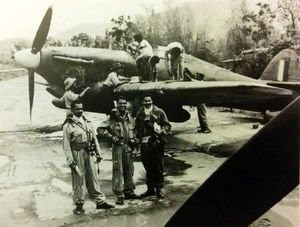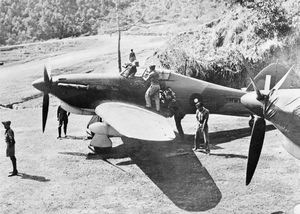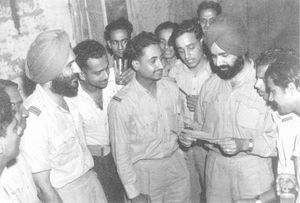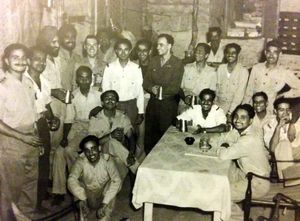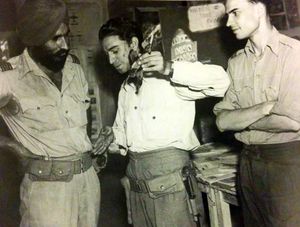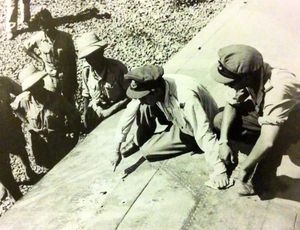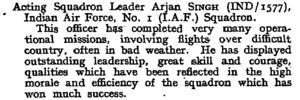May
In May, particularly towards the end of the month, weather was bad. Monsoon had broken earlier and with greater violence than usual, cutting down the hours of flying and making many sorties abortive. Yet No. 1 Squadron flew a total of 372 sorties of which 32 were by night. This was the first time the squadron took part in night operations. The hours flown during May totalled 493. The average sortie duration was increased by roughly 15 minutes as the Hurricanes were now fitted with Long Range tanks. These large tanks with which the aircraft had to be fitted for undertaking long-range tasks reduced their speed rendering them easy targets for opposing fighters. Flying was therefore limited to within 100 miles radius of Imphal.
|
Prabhakaran, Rajaram and Hafeez at Imphal in front of a Hurricane IIB with long range tanks. Prabhakaran and Hafeez were lost during a single sortie in late July when they went into clouds and crashed after flying into terrain.
A Hurricane IIB of the Squadron fitted with long range fuel tanks that were fitted in May 1944 |
In May, No. 1 Squadron’s aircraft ranged over almost the entire battlefield. In the area north-east of Imphal, the Japanese 15th Division was being gradually pushed back and No. 1 Squadron flew many sorties to locate Allied troops and notice signs of activity on the part of the Japanese. In the Palel area, the 17th Indian Division was locked in combat with the Japanese 33rd Division in the vicinity of a village south-west of Imphal. The fighting was particularly fierce around the Japanese positions south of Bishenpur. No. 1 Squadron’s pilots maintained a continuous patrol. Besides the usual tactical reconnaissance of the battle area, the squadron performed other useful tasks.
8th May – Andrade is lost
On 8th May, Flying Officer T A M Andrade was shot down. His was the penultimate mission of the day – which saw 17 sorties being flown by the squadron. Andrade and B R Rao took off at 4pm for a long recce sortie. Somewhere over Homalin, his Hurricane was seen going down in flames – apparently hit by ground fire.
Six days later, 14th May, Squadron Leader Arjan Singh, flying on a Tac/R mission with Fg Offr Prabhakaran noticed that the Japanese had strung a steel cable across a river at around 50-60 feet height, expecting low flying aircraft to fly into it and crash. They had reported its presence to HQ to warn other pilots.
The DFC :
On 18th May, the routine schedule of operations was interrupted. No sorties were planned, no aircraft were prepared, infact the orderly room had stopped working and were having tea, as if there was no war going on. As the day proceeded more and more sections stopped working and it became clear that the unit was taking the day off – to celebrate. A message from the AOC, Air Marshal Sir John Baldwin arrived. It stated:
“For the first time in India’s history, Squadrons of fighters and Dive bombers manned by Indian pilots have operated in strength against the enemy. As part fo the third tactical air force, Iwhich I am proud to command, the air and ground crews of the IAF have made a significant contribution to our success. You and your pilots have won honour and glory. Squadron Leader Mehar Singh, who commands No.6 squadron was awarded the DSO for his brilliant exploits, against the Japanese. He is the first of your fellow countrymen in the Indian Air Force to win this decoration.
You yourself have been awarded the Distinguished Fflying Cross and one Indian Air Force Squadron which you command and which participated in distinction in the Burma campaign of 1942, is back again on operations. “
The celebration party that night went into the wee hours of the morning. Copious amounts of liquor was consumed, and many a pilot was rendered grounded by the after effects the next day!
The DFC Celebrations
Potsangharn village near Bishenpur was occupied by the Allies on the 19th of May, reports of continued fighting in the neighbourhood on the succeeding days showed that the Japanese were clinging desperately to their positions. Bombers of the Strategic Air Force dropped about 200 tons of bombs between the 5th and the 10th and one of the tasks of No. 1 Squadron was to assess the damage done by the bombs. Addtionally the pilots dropped leaflets in various areas on several occasions.
On 20th May, Fg Offr P N Sanyal was badly injured when an RAF Spitfire struck the Hurricane in which he was seated. The Hurricane HW806 was written off.
The First Air Combat:
On 21st May two aircraft of the squadron’s ‘B’ Flight, flown by Pilot Officer N S Masih, and Fg Offr M M A Cheema, encountered Japanese fighters for the first time.
The pair had taken off at 6:15am to patrol the area near Bishenpur, where the Allied troops have established a presence a few days earlier. They returned due to radio problems and subsequently took off again at 6:40am. As luck would have it, they ran into a massive Japanese formation of bombers escorted by Oscar fighters.
An army patrol on the ground saw a formation of ten Oscar fighters, out of which six of them swooped down on Masih and Cheema. The Hurricanes were fitted with long-range tanks and were reconnoitring the Bishenpur area at 1,500 feet when they were attacked by the six Japanese Oscars from above. The slow moving Hurricanes had little chance of escape. Masih was shot down first. One of his fuel tanks got hit and caught fire. Cheema had a miraculous escape. His aircraft’s main plane had been hit and the long-range petrol tank had caught fire. He jettisoned the petrol tank and broke into the attackers. He then hit the deck and though chased up to Tulilial, managed to escape.
Hearing about the loss, ‘B’ Flight commander, Haider Raza and Fg Offr A M Kapur made another sortie to Bishenpur an hour later. They spotted Masih’s Hurricane – crashed and still burning on the ground. There was no sign of the Japanese. The wreckage of Masih’s Hurricane was later located on the ground by two RAF Officers sent from Imphal to investigate. The wreck was about 3 miles from where spot where the army positions were witness to the air battles. Masih’s fighter was just one of the ten Hurricanes lost in that month by the Allied Forces.
|
Flying Officer M M A Cheema, who evaded six Japanese fighters over Bishenpur, narrates his escape to Squadron Leader Arjan Singh, while Flight Lieutenant Raza looks on. |
|
Cheema points out the bullet holes in the Port wing of his Hurricane after his escape from the Japanese fighters. |
|
On 30th May, the London Gazette officially published the award of the DFC to Squadron Leader Arjan Singh. |
